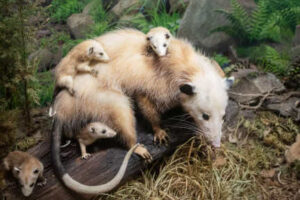The World Around Us:
Opossums
Cute, or ugly, welcomed or not, it’s hard to disagree that the opossum is certainly one of our more interesting outdoor neighbors here in New York.

So, is it opossum or possum? Actually, in North America, it’s an opossum. Though many refer to the Virginia opossum as “possum,” a possum is a related marsupial located in Australia. The name “opossum” is derived from an Algonquian Indian word “apasum,” meaning white animal. While there are over 65 species of possums, only one, the Virginia opossum, is native to North America. Weighing 4 to 15 pounds, it is our only marsupial.
Around for nearly 70 million years, the opossum has been able to adapt to environments ranging from forests to cities and everywhere in between. Affectionately known as “nature’s little sanitizers,” they are often welcomed by humans for their diet of bugs, rodents, rotted fruits, and most importantly, ticks. It’s estimated that one opossum consumes 5,000 ticks each year. Opossums eat mostly at night, but can be seen foraging during the day, especially during the harsh winter months.
Having the shortest gestation period of any mammal, opossums give birth to up to 20 babies less than two weeks after mating. In the northern states, they have one litter per year, but those living in the warmer southern states have been known to have two or three litters annually. Soon after birth, these joeys, about the size of a grain of rice, travel to their mother’s pouch. Only about half survive the journey. Between two and four months, the joeys leave the pouch and ride on their mother’s back, and will venture on their own at six months.
The opossum has a lower body temperature than most mammals which makes them a difficult host for some common diseases, including rabies. Opossums are eight times less likely to contract rabies compared to other mammals. Due to the peptide protein in their blood, they also have a high immunity to snake venoms and many poisons.
Opossums can carry a disease known as EPM (equine protozoal myeloencephalitis), a neurological disease horses may acquire by eating infected opossum feces. If you have horses, store their grain in covered bins, and deter opossums from the area.
Hanging garden flags and windsocks, keeping a radio on, and putting pet hair and garlic around the proximity of your home, or barn, are some humane ways to keep opossums away.
Opossums are peaceful animals who are generally very shy and stay away from people and other animals. When feeling threatened, they may hiss, growl, and show their 50 very sharp teeth. When very frightened, they will feign sickness by drooling from their mouth and nose, or “playing dead.” “Apparent death” occurs under extreme duress and is an involuntary reaction where the opossum loses consciousness and has no reflexes. When the threat is gone, the opossum regains consciousness and goes on his/her way.
So, cute or ugly, welcomed or not, it’s best to enjoy opossums from a distance. However, should you come across an opossum who is injured or orphaned, please contact a wildlife rehabilitator or your local vet. Remember, everyone, and everything, in nature has beauty and value.